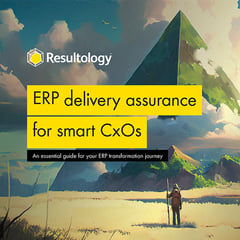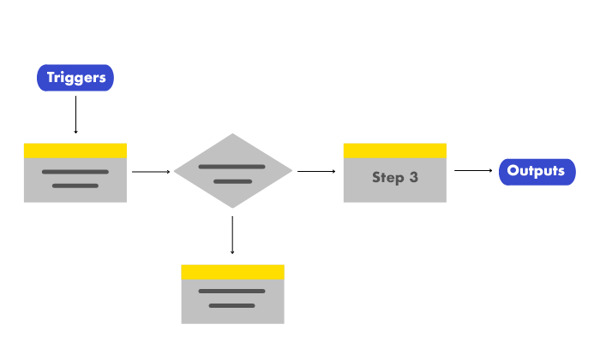WHAT ARE BUSINESS PROCESSES?
So what is a process?
In its simplest form it’s just a recipe, a series of actions that are taken to achieve a particular goal or outcome. When baking, the ingredients are combined following a number of steps defined in a recipe to produce an output, for example a cake.
A process basically transforms an input into an output.
How complex the process that transforms the input to the output is can vary massively from the very simple (the cake) to the very complex (production of a vaccine) depending on the scenario.
So what does this translate to in business terms?
Organisations generally sell either a product or they provide a service. To sell the product or provide the service the business performs a number of activities or tasks. Some activities are dependent upon the completion of the previous activity before they can be performed, others can be performed at the same time as other activities. These business tasks or activities are known as business processes. In a nutshell a business process is a series of steps or actions taken by a company that transforms inputs into higher value outputs.
WHY ARE BUSINESS PROCESSES SO IMPORTANT IN ERP?
Two people can make the same cake using the same recipe with completely different outcomes. There are plenty of factors that can influence whether the cake is light and fluffy, heavy and dry, burnt or just right.
Whether it’s a success or a failure.
The same is true of your business processes. Your ‘recipes’ enable your business to function, the better your ‘recipes’ the better your business will operate, the more productive your organisation will be and the more money you will make.
Business processes play a fundamental role in how the organisation functions.
They are unique to your organisation almost like a fingerprint, they differentiate you from your competitors. They determine how successful you are and how you perform in the marketplace. They shape whether you are a market leader or a market follower. In short they are the key building blocks of your business and the secret to your success.
Your business processes determine whether your ‘cake’ is better than your competitors or not.
We can relate this to our own experiences.
Think about it, how many times have you bought something and been frustrated by the whole experience?
Parcels that take days to be dispatched and even longer to arrive, and god forbid you need to return an item or it arrives damaged, tearing your hair out just trying to speak to someone who can help or do something.
We’ve all been there; this is all generally a result of bad business processes.
The flip side of this is goods that are dispatched within hours of being ordered and that are on your doorstep within 24 hours of hitting the purchase button. Or an easy to understand returns process, where the returns are dealt with as quickly as the initial order.
THE RESULT OF A GOOD BUSINESS PROCESSES IN ERP
This is how some organisations can get it right, and others get it so drastically wrong. Of course no organisation is perfect, sometimes things do go wrong but the better and more robust business processes that the organisation has in place, the better equipped they are to respond when things do go wrong.
The long and short of it is that business processes directly impact your customer experience and influence your perception of the organisation.
Next time around who are you going to buy from? For an organisation, knowing and understanding their business processes is the accelerator to proactively improving business performance.
Good business processes help to:
-
Attract customers and turn them into loyal fans who keep coming back.
-
Eliminate operational waste that erodes profit and costs money, for example reducing transportation times of goods, improving manufacturing processes to reduce the number of defects that result in rework or goods being returned.
-
Differentiate your organisation from everyone else.
In an ever changing world businesses need to adapt and evolve to stay relevant and successful.
This might mean changing their strategy or adapting their business model for example selling online rather than just through a shop. A large number of high street retailers have fallen foul of this with catastrophic consequences.
How relevant is dvd rental in an on demand world?
As such their business processes also need to adapt and evolve to support them.
Your business processes are not static, they need to change over time to survive in the marketplace.
CORE BUSINESS PROCESSES IN ERP
We know that business processes are unique to each organisation, it’s not a one size fits all approach.
That said there are a number of high-level core business processes that every business will undertake regardless of the type of business they do. At a high-level the business process will be the same with variations at a detailed level depending on the type of business. It’s a fact that all businesses buy products from suppliers. The types of products purchased will vary massively depending on the type of business they are.
It might be raw materials to be used in a manufacturing process such as mild steel, glass, plastic, precious metal. Or in a food manufacturing process raw food ingredients - meat or vegetables or pasta.
It might be IT equipment such as laptops, and printers, or office supplies in the form of paper, pens, printer cartridges, telephones or just general sundry items such as toilet rolls and cleaning products.
Irrespective of the type of product being purchased, every business buys things and once the goods are received they have to pay for them.
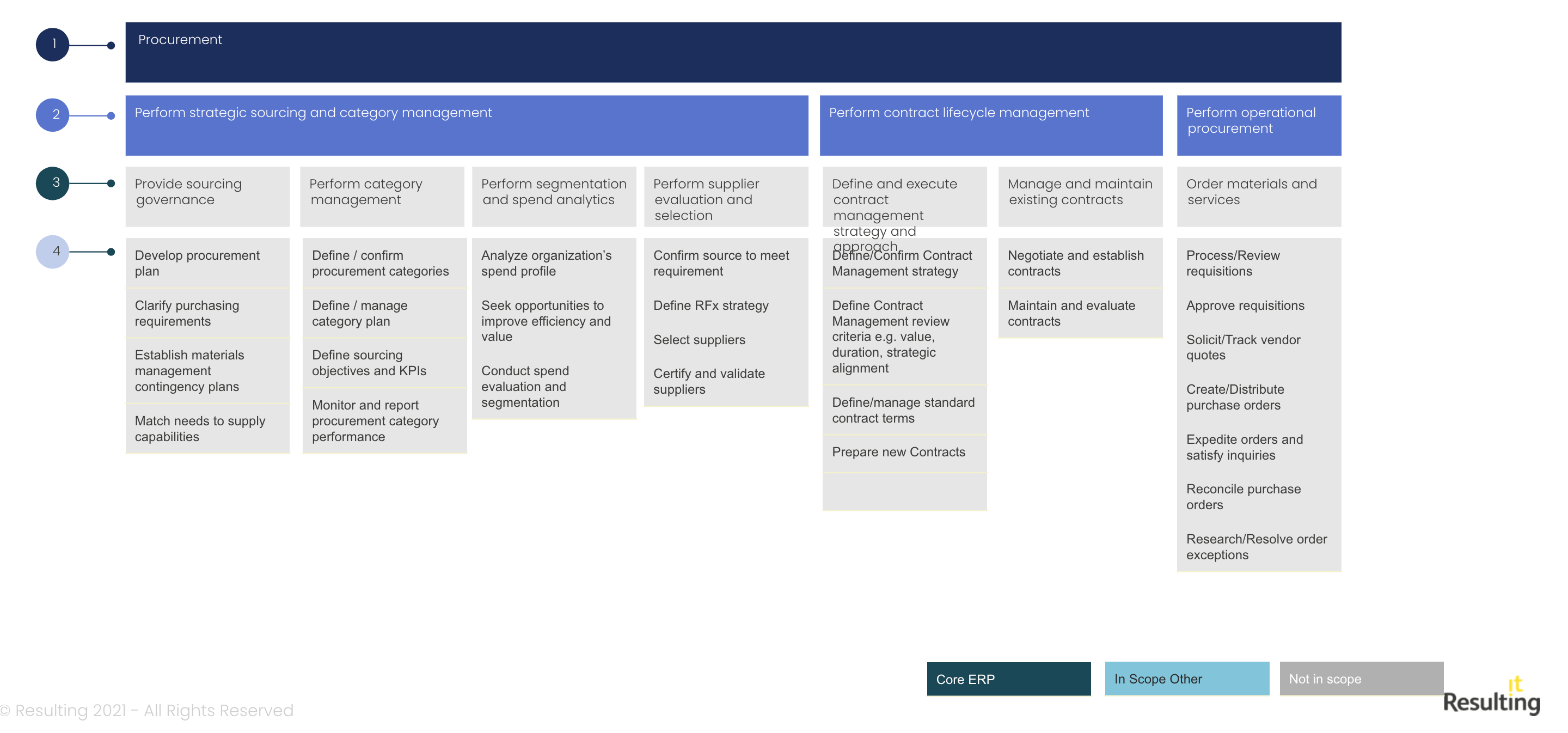
This core business process is known as Procure to Pay. It covers the purchase of a product through to payment and the associated analysis to make sure you aren’t paying too much for goods.
Organisations generally need some kind of income to operate in the marketplace and be financially viable as a business, the long and short of it is they need to make money to survive. So they will generally sell something to a customer, this may be an actual product or a service of some description.
Again this will vary from organisation to organisation, some will sell a single simple product, some will sell multiple complex products or services. Customers pay for the product or service they receive.
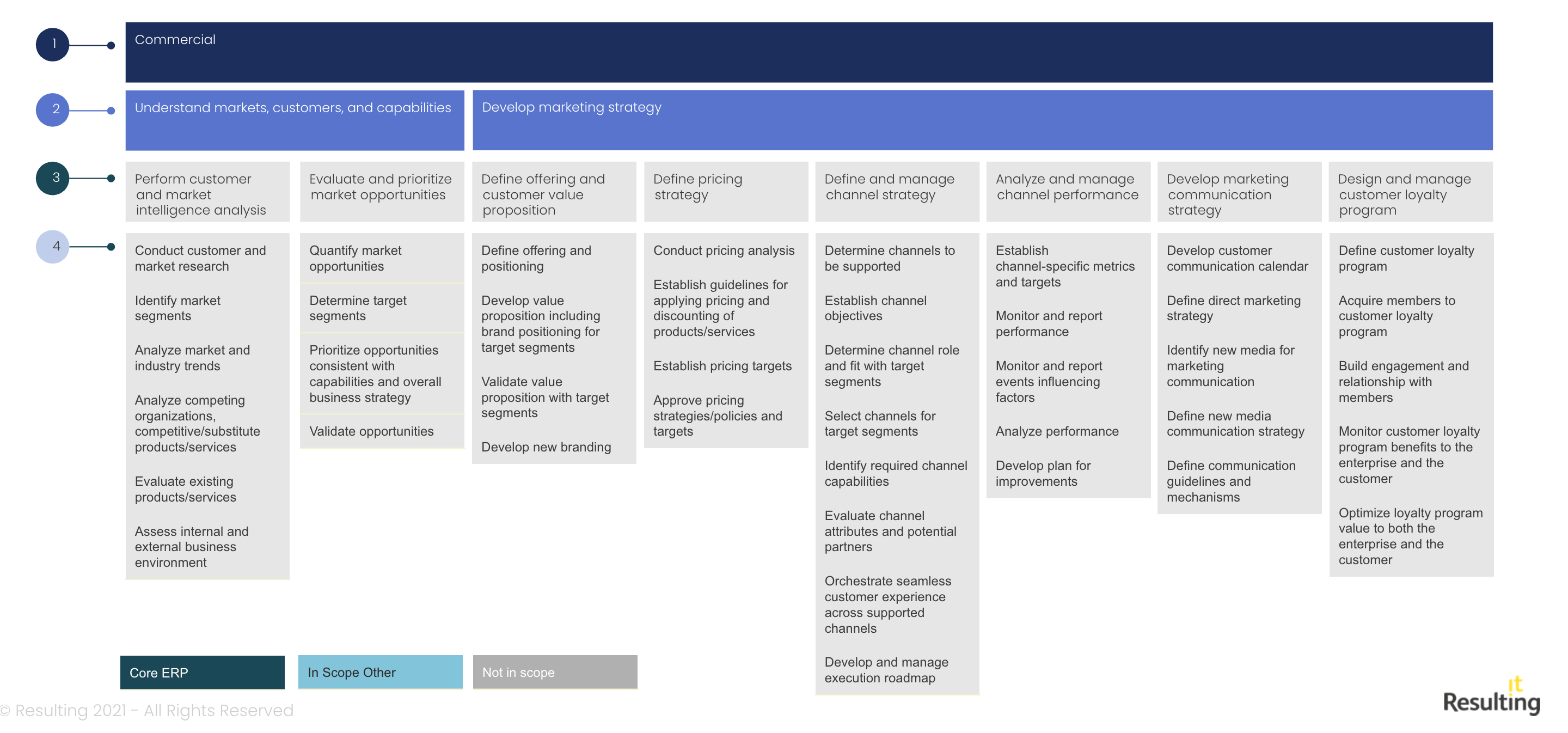
This core business process is known as Order to Cash.
It starts when the customer places an order through to the receipt of the payment to clear the debt and the analysis of the process thereafter.
All businesses have a responsibility to accurately collect, process and record financial transactions to report the performance of the business.
On the one hand this enables them to meet their legal financial obligations in terms of reporting to Government Departments and ensuring they pay the correct tax.
On the other hand it fulfils the internal requirements from the management team and investors, who want to understand how the company has performed, what their return on investment may be. It also provides data upon which decisions will be made in relation to the future of the business and its direction.
This core business process is known as Record to Report, recording the business activities and reporting them.
DIFFERENT ERP BUSINESS PROCESSES TO SUIT DIFFERENT INDUSTRY NEEDS
Alongside the core business processes, a number of additional business processes will be driven by the industry in which the organisation operates.
For example, the Aerospace industry has to adhere to various safety regulations to make sure that their planes are safe and won’t fall out of the sky. So they have business processes in place that ensure they meet the required safety standards and have full traceability of the tests they’ve carried out to support this.
In a similar vein, due to the nature of their business, the Pharmaceutical industry has legislative and legal requirements it has to adhere to, good manufacturing practices they have to fulfil.
They need to be able to prove that their medicines and vaccines are safe for us to take and that they have been produced to a safe standard and properly tested.
Their business processes will ensure that manufacturing processes are robust and that they are able to monitor and capture the results of clinical tests.
Food manufacturers need to make sure that the products we consume are safe and meet the standards laid out by the government. Their business processes need to ensure full traceability of their products. They have to be able to report exactly what ingredients have been used in which products and where the raw ingredients originated from.
Retailers such as our e-bike retailer Sparxycle need to know what products are selling and be able to predict what is likely to sell so they can make sure they have the right products on the shelves at the right time.
They need to predict seasonal variations and things that will influence their customers' buying habits. Again their business processes will reflect this.
Although there is greater alignment of business processes within an industry there will still be nuances that are particular to the individual business depending on the products they make and how they are organised, which is why business processes are unique.
ERP PROCESS FRAMEWORK
So you’d assume that every organisation fully understands all the processes it conducts as part of its’ business, it’s a no brainer right? To run the business you need to know what exactly you do and how exactly you do it.
You would think so but some recent research shows that around 72% of organisations who run SAP did not have a definitive, up to date list of business processes. We can only assume the same is true across all ERP customers.
Given what we know about ERP and that it is essentially a business process application, this is a pretty fundamental gap within an organisation to proactively improve business performance.
One option for capturing the scope of your business processes is in the form of a Process Framework.
In its simplest form this is a list of the key processes performed by an organisation, grouped in a hierarchy to show how they relate to each other. This aims to provide a standard process framework and a common language to drive consistency and standardisation across the business.
It details the complete scope of an organisations’ business processes in a single, centralised, global repository.
It doesn’t need any fancy technology to support it, a simple spreadsheet that lists out each business process by function is as good a starting point as any.
And a major plus point is you don’t have to start from scratch to create a Process Framework. APQC (American Productivity & Quality Center) is the world's foremost authority in benchmarking, best practices, process and performance improvement, and knowledge management.
They have a Process Classification Framework (PCF) that is a reliable and robust framework used by hundreds of leading companies worldwide. It’s a great starting point for building your Process List.
So once you’ve got your definitive list of business processes what then? You want to look at ways of practically increasing your organisational efficiency by improving your business processes. Optimise your business processes to optimise goals, to optimise financial returns and to eliminate waste and inefficiencies.
Why does it take our Warehouse team 3 days to pick, pack, and dispatch an order when a customer places it online? And why does it take a further 3 days for it to arrive with the customer? Our competitors can get it to the customer within 24 hours - why? What makes them so efficient? They’ve got better, optimised business processes, that’s what.
How can we optimise our business processes? There are various approaches and methodologies that can be used.
One option is to augment the Process Framework with additional information that can then be used to categorise and classify a number of different ways to drive out different views of the processes.
For example, add complexity to each of the processes and categorise it Low - Medium - High to understand which are the most complex processes within the business. That might be a good place to start looking for improvements.
This is called a Process Framework Catalogue, you can find more info here.
ERP BUSINESS PROCESS DOCUMENTS
Every activity or business process will have some type of document or output generated to support it and to provide an audit trail of what’s happened.
It might be a physical paper output that’s printed and shared, an electronic output that’s generated and sent, or a reference number.
Each document generated off the back of a business process will be assigned a unique reference for ease of tracking and audit.
If we go back to our Amazon example, when you hit the ‘buy it now’ button this signals your commitment to the transaction and to buy.
This triggers Amazon’s sales order fulfilment process and a chain of events in their ERP system that ultimately results in you receiving your Amazon delivery.
A document will be generated as an output of each of the processes that lead to your order being fulfilled.
You commit to buying an Amazon product, their ERP system creates a sales order (SO), this is a commercial document that confirms the sale of the goods.
This signals that Amazon is prepared to fulfil your order and send you your goods.
It’s a document created by the supplier with a unique reference ID that enables you and them to track the order’s progress and where it is in the sales fulfilment cycle.
The sales order contains information about the sale, including details of the product purchased, quantity required, price, address to which the goods are to be delivered, potential date of delivery and how the goods have been paid for.
Behind the scenes the ERP system creates another output generating a sales invoice which is your bill for the goods you’ve purchased. This customer invoice specifies the amount you owe in exchange for the product you’ve bought.
When you’ve entered your payment details on the order and it’s been authorised and the money received, a further output document is generated to confirm the receipt of funds.
A remittance advice confirmation is received by the supplier to indicate that the payment has been made, then the sales invoice is marked as paid and the process of fulfilling your order begins.
With online retailers this process and the creation of the associated business documents i.e. the order, invoice and payment advice is seamless and all happen in a single transaction.
In other transactions this may be split into a number of individual steps, but the principal's the same.
So what now?
Amazon has received your order, how do they go about fulfilling it?
Their ERP system will verify if they can fulfil the order immediately by checking their stock availability. If the item is in stock, they’ll generate an inventory pick list, this instructs the warehouse how the order should be fulfilled.
The pick list is another business process document, outlines the details of the product to be picked, the quantity and the location in the warehouse – a bit like when you visit IKEA and the product ticket tells you which aisle and shelf location you can find your “Billy Bookcase” on.
Once your product has been picked, an Amazon employee puts it in a box and prints a delivery note that will be attached to the parcel.
The delivery note is basically the order checklist, it lets the operator check they’ve included everything you ordered in the package, but it’s also your checklist as the customer to verify that you’ve received everything you’ve ordered.
It’s particularly useful when orders have been split into multiple deliveries. The delivery note simply states product codes and quantities, not values.
Your order’s now packed and ready to be shipped from the warehouse to you using a delivery service. When the delivery arrives on your doorstep the delivery driver will update the ERP system to tell it you have successfully received your goods and that your order has been successfully fulfilled.
Depending on the demand for products Amazon may need to restock items to fulfil the sales demand again this process generates a number of output documents that enable us to track and audit the process.
To restock goods they will create a Purchase Requisition, which signals their intent to purchase goods.
The purchase requisition is the first step in the buying process, it’s an internal document that requires review and approval to verify that the purchase is required and valid. This may be a manager or someone within the finance department. This prevents fraudulent purchases being made.
When the purchase requisition has been approved, it’s converted into a Purchase Order (PO). The PO is the external document we share with our supplier to indicate our intent and commitment to purchase goods from them.
Purchase orders generally include your organisation’s names, description and quantity of the goods you are purchasing, invoice address, payment information and a unique PO reference.
Upon receipt of your PO, your supplier will convert it into a Sales Order which they will then fulfil through the sales order fulfilment process. When the supplier has fulfilled the order and Amazon receives their goods, they will raise a Goods Receipt (GR) document in their ERP system. This is their acknowledgment that the goods have been received and are now available in stock.
Once the goods are in stock then Amazon can start the fulfilment of your online order.
When Amazon has acknowledged receipt of the goods and there are no issues, the supplier will invoice them for the cost of the goods they have purchased. This details the amount that Amazon has to pay for the goods they’ve received. It details what they owe their supplier.
This supplier invoice will be recorded on their ERP system and paid to clear the outstanding debt. Every step of the business process produces a document with a unique reference for ease of identification, tracking and audit purposes.
WHAT IS ERP PROCESSES MAPPING?
So we understand processes but what about a process map?
Process maps provide a visual representation of all the steps and activities which may influence or contribute to the process, it may also detail the people involved in executing the process.
By creating a single, centralised visual map of the steps in a process we can better understand the process end-to-end. The old adage “a picture is worth a thousand words” is true in terms of process mapping.
To map a business process you simply draw a box for each step and connect them with arrows to show sequential flow.
Let’s take a simple example .... ordering a coffee at any of the usual suspect coffee chains on the high street.
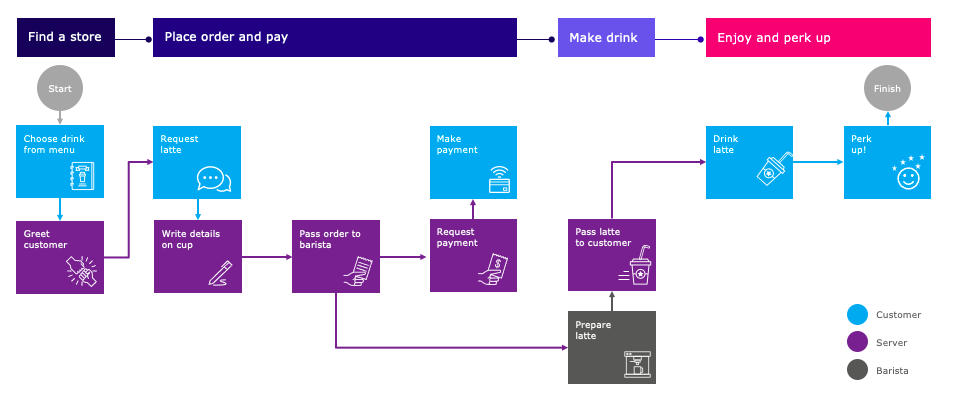
The point you decide that you need a coffee to perk you up triggers a number of steps within a process, a number of decisions that have to be made - type of coffee, size of cup, type of milk, whether you want sugar and so the list goes on. It also triggers a number of actions that have to be taken and interactions between individuals.
If we represent this simple transaction as a process map we can clearly understand the end to end process. In business terms process mapping can be an effective tool to drive standardisation and improvement across the business.
Processes change over time, new requirements come up, new ideas arise, technology changes and processes are required to change and adapt to accommodate all the varying requests.
IT Systems may be deficient, solutions may have been put in place that at the time were the best proposed way forward but now are outdated and obsolete. There may be steps in a process that are no longer required due to changes in technology, legislation, or management reporting that no one has ever questioned and as such continue to be done day in day out, week in week out, month in month out.
Process mapping provides us with a tool to identify inefficiencies and waste, and to standardise and change processes.
There are loads of different types of process maps and different ways they can be visualised depending on the goal, the audience and the level of detail required.
Here are three of the most commonly used ones you’ll come across in the ERP world.
HIGH LEVEL ERP PROCESS MAPS
A high-level process map shows how the process works in a few consolidated steps. It’s often best to begin with the high-level process map to try and get some order from the chaos.
It enables you to identify where the detailed focus needs to be.
Purpose:
-
Provides quick and easy insights into what the process does without getting bogged down in the detail of how it’s done.
-
Provides a quick, easy to understand snapshot of the process.
-
Doesn’t require deep detailed knowledge of the process at a transactional, hands on level, they are therefore quicker to collate and build.
DETAILED ERP PROCESS MAPS
A detailed process map is a flowchart that shows a detailed drill-down version of an individual business process and details the sub tasks within this process. It illustrates a process at a detailed activity level.
Purpose:
-
Useful for understanding the intricacies of an individual process. Assists in understanding the sequential flow of the process.
-
Includes subprocesses which makes this useful for identifying inefficiencies and for documenting decision points within a process
-
Requires process experts for input to provide the level of detail required for mapping.
The reality is that we don’t usually need to see the entire business process end to end in detail, but there may be individual parts of the process that require a deeper understanding especially if there are issues within a particular step, or a particular process step is known to be problematic or time consuming.
The key is selectively diving into the detail.
SWIMLANE DIAGRAMS FOR ERP PROCESS MAPPING
A swimlane diagram is another commonly used visual process map, it is at a similar level to a detailed process map, but it also shows the relationships and interactions between process steps and the teams or departments responsible for executing them.
Purpose:
-
Shows “who does what”
-
Activities are separated into lanes according to who is responsible for performing the process task
-
Requires detailed process knowledge of the end-to-end scenario to map
-
Assists in understanding the sequential flow of the process
-
Help stakeholders and management to understand workflows, interactions between teams and handoffs between teams
-
Help to increase accountability and ownership across the business
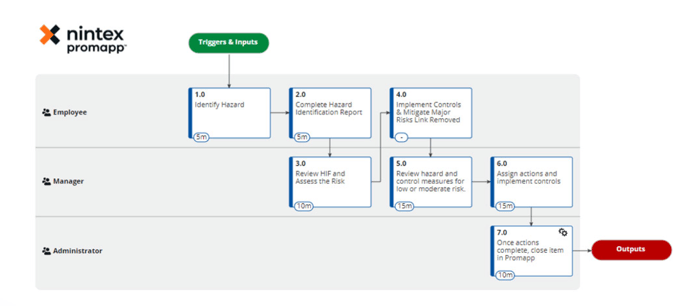
(Source, Nintex)
Does it make sense to map and maintain every individual business activity at a detailed level and show the interactions between functions in swimlanes?
Probably not, some business activities may be simple and straightforward, they may follow a standardised system process and add little value to the overall process, for example, running a report. As such they probably don’t warrant the time or effort to be mapped at a detailed task level.
The key to effective process mapping is defining the level at which we want to map and maintain process flows for reference and audit purposes. Where should we expand our efforts in order to maximise our time and effort and to add the most value?
SEGREGATION OF DUTIES IN ERP BUSINESS PROCESSES
Imagine if the keys, lock and codes for a nuclear weapon system were all in the hands of a single person, the outcome doesn’t bear thinking about, it could be disastrous.
To prevent devastation, checks and balances are put in place which aim to prevent the disaster occurring.
Based on the risk, the government assesses protocol and ensures that the appropriate plans and contingencies are in place to keep us all safe.
-
Keys, locks and codes are shared between a number of people
-
Responsibilities are shared, multiple people are held accountable
-
They ensure that no single person can activate the nuclear weapon
Although not negated fully, the overall risk is certainly reduced.
The premise for ensuring business actions are suitably split within an organisation is the same. To protect the organisation and reduce risk to the business, critical processes are shared between a number of resources.
This sharing of responsibilities in relation to critical functions is known as Segregation of Duties (SOD).
SOD aims to reduce the risk to the business and improve internal controls, to ultimately reduce errors and fraud.
The theory’s pretty simple, no single individual should be able to check and execute all the steps in a critical transaction. No one should be able to ‘mark their own exam paper’.
For example “Joe” should not be able to raise a Purchase Order, Approve the Purchase Order and also to pay the supplier invoice.
When a single individual has the ability to carry out all the stages in a process, with no checks or accountability, the potential for errors to be made or for fraud to occur increases.
The consequences of this can be catastrophic for a business and may result in financial loss, reputational damage or inaccurate legal reporting. As such when defining processes, businesses need to give careful consideration to the individuals and roles that are involved in each step of the process.
Over the years there have been many high profile corporate fraud scandals that have seen large profitable organisations crumble. This is very often the result of the organisation not having the appropriate Segregation of Duties robustly enforced to ensure that no single individual has too much power. These checks and balances are needed at every level of the organisation right from the very top to the bottom.
ERP BUSINESS ROLES
Within any organisation there are different roles and responsibilities that need to be fulfilled.
A role refers to an individual’s position on the team or in the organisation.
The responsibilities refer to the tasks that form part of that role.
When you clearly define roles and responsibilities within an organisation, everyone knows exactly what is expected of them, they know what they need to achieve and how they will be measured.
When people understand their role responsibilities nothing gets forgotten in the process and tasks are less likely to be ignored as they have owners who are held accountable. It sounds simple, everyone needs to know what they are doing, but it often gets overlooked and that’s when balls get dropped.
The types of and names of roles can vary massively by organisation, depending on the industry and particularly the size of the organisation.
The role name is largely irrelevant as long as the individuals clearly understand their responsibilities and the business processes for which they are accountable.
Large organisations can have hugely complex hierarchical structures with various executive managers, managers, team leads responsible for specific functional aspects of the business.
This is further complicated if they operate globally, they might have a set of country managers, who report to a regional manager who reports to a global manager.
The types of and names of roles can vary massively by organisation, depending on the industry and particularly the size of the organisation.
The role name is largely irrelevant as long as the individuals clearly understand their responsibilities and the business processes for which they are accountable.
Large organisations can have hugely complex hierarchical structures with various executive managers, managers, team leads responsible for specific functional aspects of the business.
This is further complicated if they operate globally, they might have a set of country managers, who report to a regional manager who reports to a global manager.
Large organisations will generally have a team of executives responsible for the strategic management and direction of the organisation. In smaller organisations this may fall to a couple of individuals.
They will set the corporate strategies and define the direction of the business. Roles vary but the chances are that one or more of these individuals will be the senior stakeholders in your ERP solution.
They will want to know that it effectively supports the business processes.
The organisation will then be split into various departments and functions that have defined responsibilities.
The size and structure of these departments will again depend on the size and complexity of the organisation itself.
The finance function is responsible for ensuring the appropriate financial controls are in place within the organisation and for ensuring the efficient financial management of the business. They are responsible for recording and reporting all the organisation’s financial transactions accurately and adhering to defined accounting principles and policies.
They make sure bills are paid and that we in turn are reimbursed for goods and services sold. They make sure that customer and supplier accounts are accurate.
They provide updates on the financial health of the organisation.
They oversee the financial planning, legal statutory and compliance reporting, and analyse financial and non financial data to support the management reporting, planning and forecasting.
The finance department needs to understand every aspect of the business so they can support the development of the financial strategy that supports the business goals.
From an ERP perspective the Finance function will have a vested interest in the ERP solution and will use it to ensure that transactions are accurately recorded and can be fully audited to ensure accurate and robust legal and statutory reporting. They will want a robust solution to support their legal and management reporting and analytics.
The sales function is responsible for selling your product or services to customers. Depending on the size and goals of the sales team there can be various ways roles and responsibilities might be carved.
They are responsible for managing relations with existing customers and ensuring their needs are met. They ensure we as an organisation continue to sell the products and services to our existing customer base and to retain them. In addition they are looking to expand the customer base and attract new customers. Their aim is to expand your customer base and ensure sales are realistic and profitable. The customer experience is key to them.
They ensure customer satisfaction remains high ensuring that customer orders are processed and fulfilled within the defined timescales. From an ERP perspective the Sales function will have a vested interest in the ERP solution and will use it to ensure that customer transactions are accurately recorded and are fully visible against the right customer and product. They want up to the minute sales figures to evaluate whether they are achieving the project sales targets, and to determine how effective promotions etc are.
They will want a robust solution to support their sales reporting and analytics.
The procurement function is responsible for ordering and buying goods and services required to support the business.
They manage relationships with suppliers and look after supplier contracts to ensure spending within the organisation is effective.
They track and monitor supplier performance to ensure that products and services are delivered on time and that the supplier offers continued value for money.
They ensure that organisational spend is effective, negotiating and setting up deals with suppliers to ensure value for money.
They are responsible for dealing with the purchasing paperwork, raising purchase orders and ensuring purchase requisitions match purchase orders.
They chase up deliveries to ensure goods are received as per the agreed delivery and schedule.
From an ERP perspective the purchasing function will have a vested interest in the ERP solution and will use it to ensure that purchasing transactions are accurately recorded and can be fully audited to ensure accurate and robust supplier reporting. They will want a robust solution to support their supplier reporting and analytics.
Understanding the business functions and their interest in the ERP solution is fundamental in ensuring they are invested in the solution.
That said, it won’t all be smooth sailing, the business functions may well have conflicting priorities and operate in silos within areas of accountability with little collaboration across functions.
Since ERP solutions offer integrated cross functional opportunities to streamline the business need to be collaborative in their approach and ways of working to ensure they get the most from the system. This, however, is often easier said than done. Once we understand our business processes we can then determine what the scope of our ERP solution needs to be. What exactly do we want to streamline, systemise and potentially automate?
NEXT: IMPORTANT ERP PRINCIPLES
Discover the principles and practices that all ERP software is built on.







